Tabasco Style Fermented Hot Sauce
August 21, 2014 | Updated June 06, 2022
As an Amazon Associate I earn from qualifying purchases.
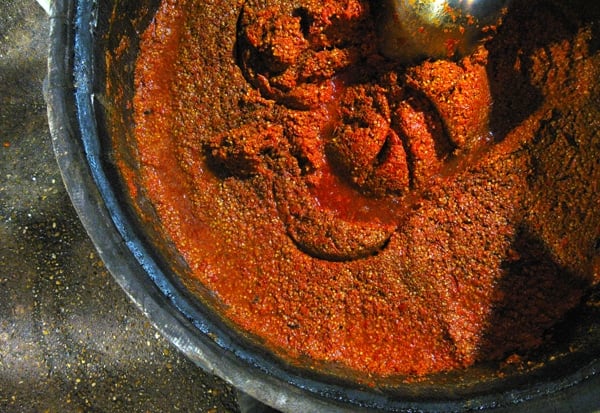
I am a Tabasco man, always have been. Sure, I love lots of hot sauces, but for me the alpha and omega of pepper sauce is Tabasco. What I didn’t know until I visited their plant was that it is a fermented hot sauce.
This slow fermentation makes sauces like Tabasco something more than just heat and vinegar, something more refined and mellow. I had no idea what that something was until I got a chance to visit Avery Island, Louisiana, and meet the McIlhenny family face to face.
Touring the plant, I was shocked to learn that the recipe for Tabasco is not some closely guarded secret. They’ll gladly tell anyone who asks what it is: Tabasco peppers, 2 1/2 percent salt, vinegar… and time. Lots of time. Winemaker-style time. Tony Simmons, the company’s CEO, walked me through it.
The Tabasco chiles are chopped up, mixed with salt mined right from the island itself, then poured into old oak barrels to ferment in a barn for up to five years, although most of the mash is fermented only (!) three years.
They then mix the mash with distilled vinegar (they used to use white wine vinegar) and let this pickle for a month, mixing all the way. Finally, they strain out the pulp and seeds and bottle the sauce.
I was fascinated by this. Aged in oak? For three years?! Damn. Gauntlet thrown. One I will gladly pick up.
Two years later, here’s how it went.
I decided to not even try to replicate Tabasco Sauce exactly, because why would I want to? Even if I succeeded, I can buy the stuff easier at the supermarket. I’d use the method, with different chiles, to make my own fermented hot sauce. Rather, two sauces: One red, one green.
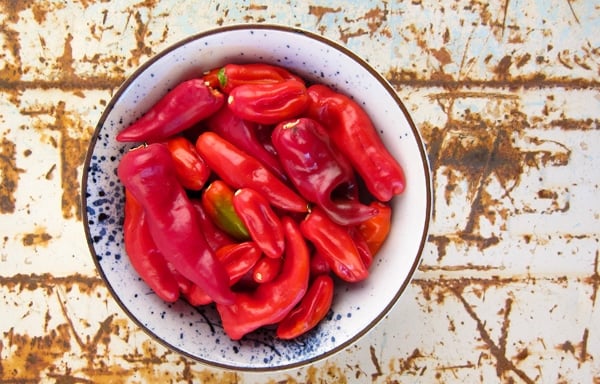
I grew a lot of chiles that year, so I used an eclectic mix of serranos, Tabascos, ripe padron chiles, and a few Thai chiles tossed in for good measure. Yes, I know doing this makes this sauce unrepeatable, but so be it. No vintage of a wine is exactly repeatable either, and since fermented hot sauce keeps almost as long as wine, it’d be fun to play with annual vintages.
I waited until late September 2012 to harvest all my chiles, and I grabbed both the red and green.
I stemmed them all and chopped them roughly, then tossed them in a food processor with that critical 2 1/2 percent salt — this is enough to protect the chiles from bad bacteria but not enough to prevent fermentation by the good bugs.
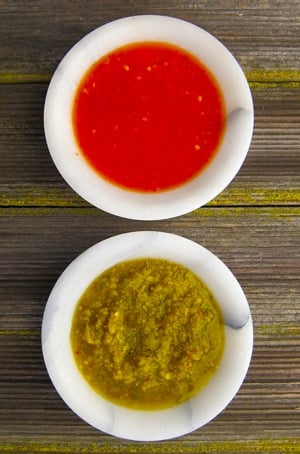
Into quart Mason jars they all went. Within a day they were fermenting, with an acrid, slightly yeasty smell that was something like a cross between Mace and a loaf of bread. Not that unpleasant, actually. I stirred the mash every day and let it breathe. After about 10 days things settled down, so I moved the jars into my salami fridge, which is a cool 55°F. But before I did that, I grabbed some toasted oak cubes I had from winemaking and tossed them in. Instant oak barrel!
And then I forgot about my hot sauce. For two full years. OK, that’s not totally true. Every few months or so I’d check on them, and once in a while a film of mold would grow on the surface; this happened three times. I just picked it off and called it good. After all, we’re dealing with chiles and salt here, both of which are pretty inhospitable ingredients to any truly bad wee beasties.
Finally, earlier this year I decided to make my sauce. I stared at that awesomely fermented mash, which was at once mellow and smooth yet muy picante, if such a thing can exist. I just couldn’t discard it. So I pureed it even smoother and added a little xanthan gum to stabilize it.
The result is a lovely hot sauce. Tangy from the fermentation, hot but not overbearing (a result of the mix of chiles I used), vinegary and a bit salty. It’s not Tabasco. It’s something different. Something… better? Perish the thought.
Fermented, Tabasco-Style Hot Sauce
Ingredients
- 3 1/3 pounds chile peppers, about 1.5 kilos
- 1 ounce kosher salt, about 37 grams
- 2 cups water
- 3 ounces oak cubes
- 4 cups white wine vinegar
- 1 teaspoon xanthan gum (optional)
Instructions
- Roughly chop the chiles and compost the stems. Blitz the chiles in a food processor or blender with the salt and water until you get a rough paste or slurry, depending on how much moisture there is in the peppers themselves. I keep the seeds in the chiles, but if you want a milder sauce, remove them.
- Put the mash into quart mason jars and cap them loosely. "Burp" the caps at least once a day to let out escaping gases and let air in. The chiles will ferment like this for at least a week, and sometimes up to 3 weeks. When the chiles settle down, add the oak cubes, distributing them evenly throughout the jars. Tighten the lids and store the jars in a cool, dark place. I kept mine in my salami fridge, which is 55°F. A basement is fine, as would a fridge. Tabasco keeps their mash barrels at ambient temperatures, which in Louisiana can top 100°F. I am working on a batch fermented this way now, and I see no reason it won't work. Don't let the mash freeze, however.
- Keep the mash like this no less than 3 months, and up to 2 years. When you are ready to finish the sauce, mix the mash with the vinegar.
- You now have two choices: You can do what Tabasco does and return the mix to the jars, shake them every day for a month and then strain out the pulp and seeds. Or, do what I do and keep all that pulp, which will give the sauce body and thickness. If you choose my method, you will need to really blend the sauce and stabilize it -- otherwise the sauce will eventually separate and will need to be shaken up before each use. To do so, dissolve the xanthan gum in 2 tablespoons of water and add it to the blender. Blend for a solid minute. Let the sauce rest for 1 hour before bottling so any trapped air in sauce (from the blending process) can escape. Bottle and store. The sauce will keep for a year or more.
Notes
Nutrition information is automatically calculated, so should only be used as an approximation.
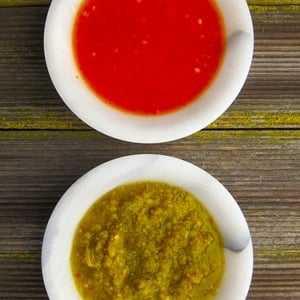
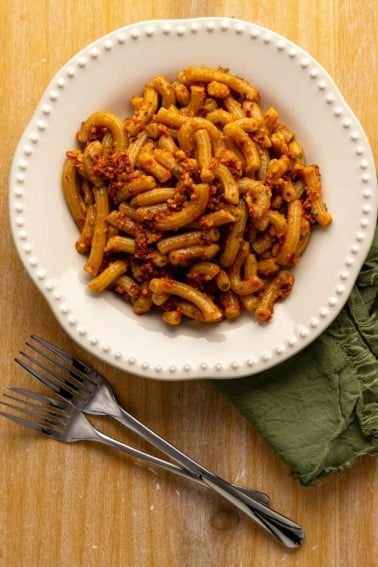
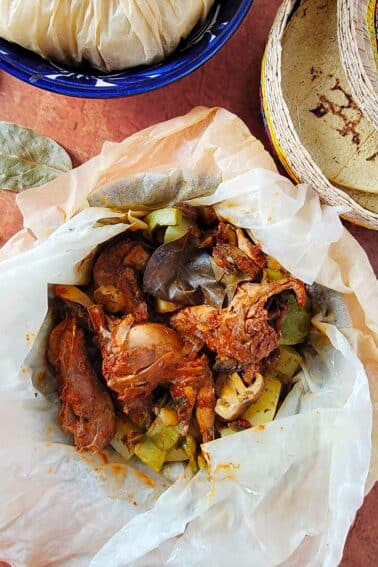

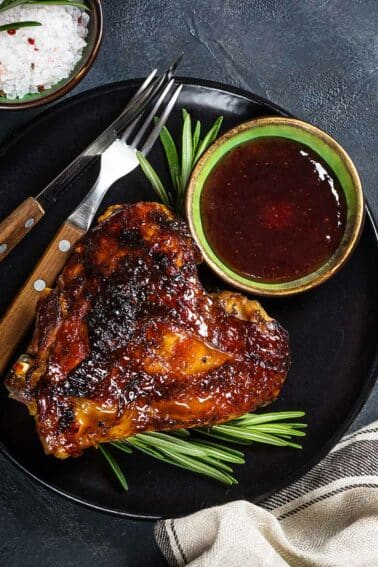
Nice recipe – I grow Tabascos and make a sauce but use 6% salt – and put an additional salt cap on top of the mash in the container (I use wine oak barrels ) I scrape it off at the end of the aging. For some reason they told me (I used to be a supplier to them), that they used 6% salt and it works for me. Perhaps the 2.5% was salt content after vinegar was added? Anyways, love all of your postings.
I just blended my first batch that I started fermenting 2.5 years ago. I wanted to let it age with the oak for six months, but life got in the way. Mash was a mix of home grown tabasco, jalapeno, thai and bird peppers with some random produce store ‘hot peppers’ added and one red bell for color. I used homemade white wine vinegar.
It’s damn good. Heat is between Red Hot and Tabasco but the heat lingers. The color is still a deep vivid red despite 2+ years in a mason jar on the top of my fridge.
Thanks for the guidance! I’m hoping to branch out this fall- maybe it won’t take me years this time! LOL
Thank you sir!
Made some from your recipe before and it was great.
A batch of juicy big green Jalapeño chunks just went in a 3 litre bottle.
The 2.5% ratio of salt seems the magic number with many ferments (‘cept cucumbers that start with 2.5 but add more salt as the luquid in the cukes dilute the brine. )
Now to wait for couple days …
Help! I’m ready to make my hot sauce after almost 2 years of aging and I have no idea how much peppers I started with. I think it was about 4x your recipe, but can not recall? Is there a ratio of mash to vinegar that you use? Ex. If I have a cup of mash, how much vinegar is used? Thanks!
R: It’s really up to you. Mix to your desired consistency.
Thanks for your quick response. I do understand that it is a preference, but I’m new to this and would love to have a range or estimate. Is it 1:1? 1:4? 1:0.5?
A ballpark estimate would be very helpful.
Thanks
R: OK, start with 4:1 fermented mix to vinegar, so like 4 cups mash to 1 cup vinegar.
Excellent!! I grow a variety of chilies in the garden. I have waited 2 FULL years for the first batch and it was worth the wait!! Question: will this sauce keep without refrigeration or do I need to can it in a water bath? If the later, then how many minutes??? Am thinking 15-20 but am not sure. Lastly, will I have to check this website for a reply or will you reply directly to me and subsequently post to the site?
Tom: I generally keep it in the fridge, but it will keep at room temperature for a long time. It will continue to ferment, though.
I know I’m late to the party, but as someone that lives 15 minutes from Avery Island I have a couple comments.
They don’t seal the peppers to ferment, after mixing with to 2.5% salt the mash goes into an open barrel the “seal” is a thick salt cap poured on top.
The oak barrels when they arrive at the factory are disassembled and cleaned, which includes removing any char on the inside. The peppers are fermented in clean oak barrels.
I personally like the flavor that the charred oak gives, I ferment in glass and and use charred live oak wood.
Michael: Thanks for those insights! I appreciate it.
Thanks Hank & hi to you all! Does anyone happen to know if the Tabasco green pepper sauce is fermented, or would I likely get closer to that with Hanks quick hot sauce recipe?
Liz: Tabasco’s green pepper sauce is indeed fermented! They put it in green glass to hide the Army green color.
Hank,
I have gathered my gear, gathered my ingredients, read enough to be thoroughly confused, and am ready to start! Do I wash my home grown peppers? Or do I leave them “dirty”?
Al: Either way. I rarely do because I don’t use sprays of any kind and they never touch dirt. But it can’t hurt.
I have cold smoked my peppers, as much heat as possible without drying them, then ran in the food processor with just a bit of filtered water to make a paste. I then place in wide mouth quart jars with a couple tablespoons of kosher salt and a table spoon of liquid from fresh sauerkraut. I place the lids on barely finger tight. I stir once a week for a month, then once a month for 4 months, then once every 4 months. This sits on my counter, center of kitchen at between 64° and 72° for at least a year. I have a batch running at 2.5 years and another at 1.5 years now. When I am ready to make sauce I use about 50/50 mash to a good vinegar ratio, 1/3-1/2 cup, adding in a heaping teaspoon of crushed garlic and a teaspoon of kosher salt, to taste.
Hi again
getting ready to bottle 2019 crop of Ghost, Carolina Reap, & Habanaro!
i would like a slightly thicker than tobasco sauce consistancy-
should i COOK the pepper/oak/vin mix when adding Xanthan gum or can i add X gum at room temp for proper blending/thickness?
Darrell: I do it at room temperature, then blend until everything warms. It doesn’t need to boil.
Actually, you should never cook a fermented sauce, this would kill all the beneficial bacteria that makes the sauce so good tasting, long lasting, and shelf stable. When you blend in a Vitamix, make sure it does not heat up too much by using cold water(with ice) and cold vinegar. Xanthan gum works wonderfully to keep the sauce from separating, just add very slowly to desired thickness.
Whenever I see percentages mentioned, I wonder a percentage of what? So, if you’re asking for 2.5% salt, does this mean 2.5% of the liquid? Example: If you have 10 tablespoons of liquid, 2 1/2 tablespoons of salt will be added? I’ve never understood the percentage ingredient. . . percentage of WHAT?
TT: 2.5% of the weight of the pepper mash plus any liquid you add.
I have been fermenting vegetables for around 3 decades; sauerkraut, kim chi, pickles of all kinds: turnip, szechuan pickle, vinegar free dills, piccalilli and hot sauce.
Here are a couple of pointers.
1) It isn’t true that raising the salt content will necessarily limit fermentation. While there is a limit, the limit is quite high. Fermentation will still take place with a salt content as high as 10 %. I suspect that the limitation to 2 1/2% here, is to match the tabasco recipe. Typical salt contents for such products are as high as 5%. Personally, I use 4% sea salt for hot sauce, which is only about 95% NaCl. Mined rock salt is purer.
2) Technically, the white film that grows on the surface is yeast, not mold. They are opportunistic yeasts, encountered on the surface of many vegetable fermentations and are oxygen dependent. Fermentation, releases CO2, which is heavier than air and when the fermentation is active, creates a blanket over the vegetables. Opening the container allows an in rush of air, displacing the CO2 but if the CO2 volume is sufficient it gets quickly replaced. Once yeast is seen forming, the fermentation has slowed to the point that very little CO2 is being created but the yeast growth has been there for 2 or 3 days already.
The idea is to limit the exposure of air to the surface of the vegetables. There are several techniques that work.
1) Use a wide jar with a tight fitting lid. Fill the jar only about 1/2 way. Each day after filling, rotate the jar in one direction only, 360 degrees in four increments. Do a complete rotation about 3 times. The process is similar to a front loading washing machine. Each 1/4 rotation will cause the back side of the rotation to spill over the foreside. In 3 or 4 rotations the original top contents will be well under. This not only serves to homogenize the contents but kills any yeasts that have started to colonize the surface. When the fermentation is very active, the lid of this fermentor will dome a little. These types of fermentations are much gentler than an alcoholic fermentation and there is virtually no danger of a sealed container bursting but if you feel the dome is too great, just undo the lid and burp the contents occasionally but be careful towards the declining side of the fermentation to not release important volumes of CO2. The rotary technique, really keeps the yeasts down. It is possible to keep them down to nothing, with care.
2) Another technique is to establish an airlock. Specialized jars exist for szechuan pickle that have a moat around the lid, and an overhanging lid that dips into the moat, allowing CO2 out and no air in. One could also fashion a jar with the type of fermentation lock used for wine.
3) Stirring. Stirring the contents well daily, will inhibit yeasts but you also release the protective layer of CO2. If you opt for stirring, it must be regularly and rigorous in order to suppress yeast growth.
4) Skimming. Skimming is by far the least effective method of inhibiting spoilage because by the time you see the yeast bloom, it has already been there for a while. Yeasts can cause off flavours and mushy structure. You also need to dig pretty deep in order to get to the lower levels of yeast growth, so you lose contents. It could be argued that due to the fact that some fermented foods go back to extreme antiquity and even tabasco back almost 200 years, and that no fancy yeast controls were available then, so why are they necessary? It also could be argued that a certain amount of the flavour imparted by yeasts is integral to the flavour of many fermented foods. Kim Chi for instance can be divided into fresh kim chi and aged kim chi where the flavours of yeast can be very evident. Many Korean children will attest to the undesirability of having to eat yeast imbued Kim Chi soup in the summer, 8 months after the yummy fresh stuff warmed their tummies on a cold fall day.
It is hard to get around the fact that with vegetable fermentations,yeasts cause spoilage. Keep the oxygen down and the CO2 up.
Limit the air space as much as possible with all techniques except 1). While this in theory limits the volume of oxygen that the yeasts can feed on, in practice, even a 1/4″ of head space will provide enough oxygen for the yeasts to thrive on. Exclusion of air is the key, not the limitation of the space it can take up. It is true though, that with a small head space, a weaker fermentation can fill that space better with CO2.
Keeping the vegetables submerged under the developing brine with a weighted plate or wooden lid is also adesirable technique and makes the skimming of surface yeasts on the brine really easy, while also removing the worry about head space.
One other piece of advice is that, once yeast is detected, the fermentation has slowed to a trickle. Advisories to ferment for weeks, sometimes as long as 6 are putting the integrity of the product at risk. I use the suns energy as much as possible and when it isn’t enough, I cozy up to some artificial heat source. I run my fermentations at 80-90 F. for about a week, after which I cool things down. Almost nothing is left to ferment by then. In the case of hot sauce, I then keep the tumbler system going for another week, by which time it might as well receive it’s vinegar dose. It will age nonetheless and the lactic ferment component will continue to completion in concert with the vinegar anyway.
The correct vinegar percentage will relieve one of the necessity for diligence when it comes to yeast contamination.
Hi Phil, I’ve been fermenting too for a few decades, and the info you’ve given above is just fabulous! I hope others read and follow your advice. Newbies to this process have to understand that if your product is heated, boiled, or canned, it will not ferment since all the bacteria are now dead. One cannot ferment without these little beasties!!
I did the same thing a few years back minus the oak, this year I added it though. One change I did try, I used my speed pot to can the mason jar. Got it up to the perfect temp. I’ll come back in a few months to let you know how the fermenting is going in a sealed jar.
Head space! That’s my problem!
Transfering mash to smaller jar w/ oak!
Post ya in a couple of months!
Thanks!
hey there!
been spending alot of time on this recipe/process/patience thing!(this is my 1st batch)…
100 pepper(ghost, reaper,habanero,red)mash is fermenting. White mold already forming after 1 week. You say you skim and this shouldn’t be a problem. I was thinking about adding more salt? Wondering if that would ward off any evil brewing in the jar?!?
waiting for oak chips to arrive to add in tomorrow and getting ready for a long winter.
Darrell: The way to inhibit mold is to not have a ton of head space in your jar. It’ll happen regardless, and I only skim like once ever month or thereabouts. Don’t ever go higher than 3% salt by weight you won’t get proper fermentation.
Nice write up, going to do tabasco peppers today. Last year did this and it was excellent.
17 jalapenos, seeded.
35 Thai chili’s. Not seeded
1 red bell pepper
1/2 yellow onion
4% saline solution
In quart sealer jar with airlock
Four weeks ferment
Oh that’s hot.
Food processor, then simmered for a couple of hours. Process with immersion blender.
2 tbs cider vinegar
Half tsp salt
Half tsp sugar
Tsp garlic powder.
Strain
Hot!! And good